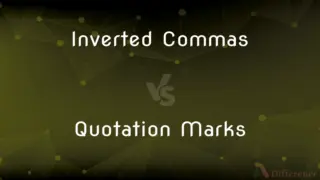501a vs. 502a — What's the Difference?
Edited by Tayyaba Rehman — By Fiza Rafique — Published on December 8, 2023
501a and 502a are numerical and alphabetical combinations, typically indicating sequence or classification. Their specific meanings vary by context, but generally, 502a follows 501a.

Difference Between 501a and 502a
Table of Contents
ADVERTISEMENT
Key Differences
501a and 502a are designations that, at a fundamental level, indicate a sequence or a classification. The presence of a number followed by a letter often suggests an ordered categorization system. In this case, 501a would precede 502a.
The exact interpretation of 501a and 502a largely depends on the context in which they're used. In some scenarios, such combinations could refer to product models, where 501a might be an earlier version, and 502a a subsequent one. This order suggests that 502a might have modifications or improvements over 501a.
In other contexts, like legal or academic documents, 501a and 502a could be section identifiers. Here, the content under 501a would be different from that under 502a, but both would be part of a larger document or set of guidelines. It's essential to reference the originating document to understand the nuances of each section.
If 501a and 502a are part of a technical or specialized field, their distinctions might be more nuanced, requiring domain-specific knowledge. Thus, without a particular context, we can only offer a broad overview of these terms and their sequential nature.
Comparison Chart
General Sequence
Precedes 502a
Follows 501a
ADVERTISEMENT
Typical Usage
Earlier version or category
Subsequent version or category
Position
Earlier in a sequence
Later in a sequence
Alphanumeric Type
Combination of number and letter
Combination of number and letter
Context Dependency
Meaning varies by context
Meaning varies by context
Compare with Definitions
501a
501a typically indicates an initial or earlier categorization in a sequence.
In the manual, 501a precedes the section labeled 502a.
502a
502a usually signifies a subsequent category or item following 501a.
After discussing 501a, we'll move to 502a.
501a
501a is a combination of numerical and alphabetical elements suggesting order.
In the list, 501a comes before 502b.
502a
502a can be a later model or iteration in certain product sequences.
The 502a version has additional functionalities not present in 501a.
501a
501a can represent an earlier model or version in product lineups.
The 501a model lacks some features found in the 502a.
502a
502a might indicate a particular section or provision in structured documents.
For penalties, refer to section 502a.
501a
501a's exact meaning often relies on the surrounding context.
Depending on the context, 501a can have various implications.
502a
502a is a combination indicating a point in an ordered list or system.
502a is usually listed after 501a in most sequences.
501a
501a might denote a specific clause or section in legal documents.
Refer to 501a for the primary obligations.
502a
The interpretation of 502a is often influenced by its specific use case.
The document defines 502a differently from what we assumed.
Common Curiosities
Is 502a always an improvement or modification of 501a?
Not necessarily. While it can be in product contexts, in other scenarios, it might just denote sequence.
What do 501a and 502a generally represent?
They typically indicate sequence or classification, with 501a preceding 502a.
Are 501a and 502a always related to each other?
While context-dependent, they often appear in sequences where 502a follows 501a.
How do 501a and 502a function in legal documents?
They might denote specific sections or clauses, with each having different content.
Are 501a and 502a universally defined?
No, their meanings vary by context and can differ across industries or fields.
Can 501a and 502a refer to product models?
Yes, in some contexts, 501a might be an earlier version than 502a.
Can 501a and 502a be related to dates or years?
While not common, it's possible in certain specialized contexts or systems.
How should I interpret 501a and 502a without context?
Without context, they generally suggest an order, with 501a coming before 502a.
Are these terms exclusive to English?
No, alphanumeric combinations like 501a and 502a can be used in various languages, depending on context.
How do I determine the exact meaning of 501a and 502a?
You'll need to refer to the specific context, document, or field they are used in.
Do 501a and 502a always indicate order?
Typically, yes, with 501a preceding 502a, but their exact implications depend on context.
Can 501a and 502a be used in academic papers?
Yes, they might indicate subsections or specific points in structured papers.
Is there a 502b following 502a?
Possibly, depending on the sequence or classification system in use.
Are 501a and 502a used in digital systems?
They could be, especially in systems requiring ordered categorization or versioning.
Are 501a and 502a terms standardized?
Their usage isn't standardized and varies based on the specific field or context.
Share Your Discovery

Previous Comparison
Inverted Commas vs. Quotation Marks
Next Comparison
Upper Motor Neuron vs. Lower Motor NeuronAuthor Spotlight
Written by
Fiza RafiqueFiza Rafique is a skilled content writer at AskDifference.com, where she meticulously refines and enhances written pieces. Drawing from her vast editorial expertise, Fiza ensures clarity, accuracy, and precision in every article. Passionate about language, she continually seeks to elevate the quality of content for readers worldwide.
Edited by
Tayyaba RehmanTayyaba Rehman is a distinguished writer, currently serving as a primary contributor to askdifference.com. As a researcher in semantics and etymology, Tayyaba's passion for the complexity of languages and their distinctions has found a perfect home on the platform. Tayyaba delves into the intricacies of language, distinguishing between commonly confused words and phrases, thereby providing clarity for readers worldwide.














































